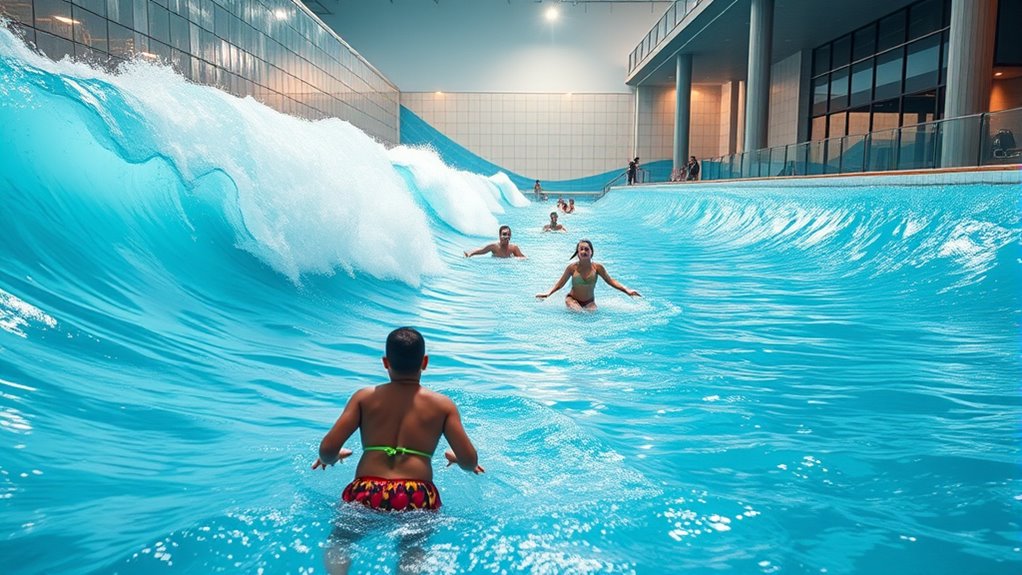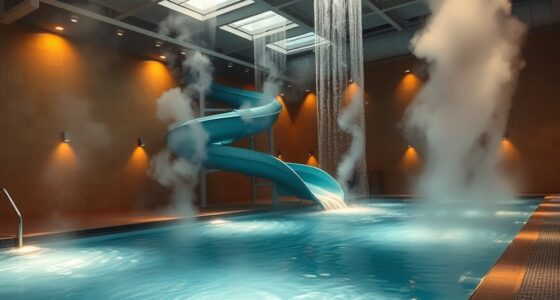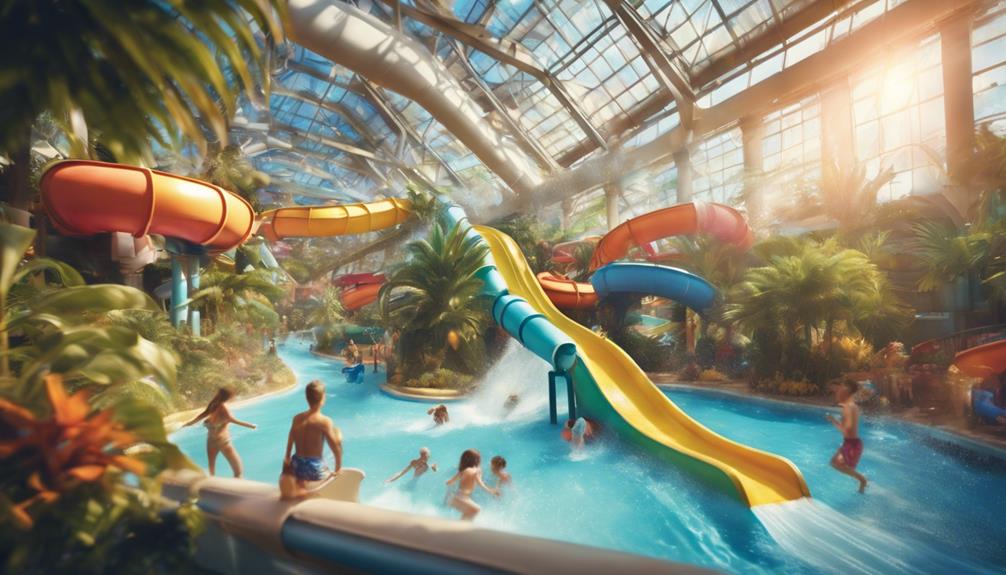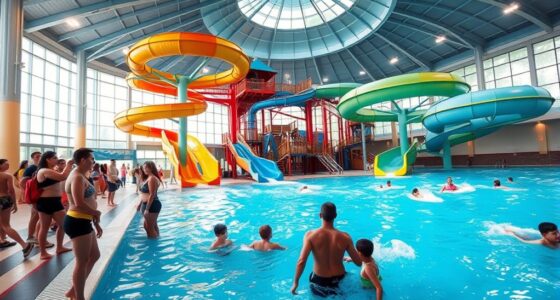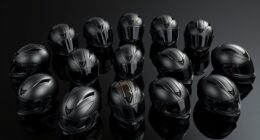Indoor wave pools use advanced systems like pneumatic, hydraulic, or electromechanical devices to create waves. These technologies generate consistent, customizable waves suited for all skill levels, with features like adjustable wave height and shape. Proper design of gutters, drains, and water management guarantees safety and water quality. The indoor environment provides controlled conditions, enhancing comfort and safety. If you want to discover more about how these innovative pools operate, you’ll find detailed insights ahead.
Key Takeaways
- Indoor wave pools use advanced systems like pneumatic, electromechanical, or hydraulic to generate consistent, customizable waves.
- Precise bottom shaping and modular wave generation technology ensure high-quality, safe waves suitable for all skill levels.
- Water management involves specialized gutters and drains to maintain clarity, safety, and efficient circulation.
- Climate control and ventilation systems create comfortable, predictable indoor environments for year-round use.
- Regular maintenance and safety protocols ensure reliable operation and a secure experience for users.
The Technologies Behind Indoor Wave Pools

Indoor wave pools rely on advanced technologies to generate surfable waves consistently and efficiently. Pneumatic systems like PerfectSwell by American Wave Machines use air pressure within sealed caissons to displace water and create waves. You can easily adjust wave size and shape with digital controls, and since there are no moving parts in the water, reliability increases. These systems can produce up to 10 large waves per minute, making them suitable for various venues. Alternatively, electromechanical setups like Wavegarden Cove use mechanized paddles that push water to form different wave types. They can generate hundreds of waves per hour, accommodating many surfers simultaneously, and are highly energy-efficient. Hydraulic systems, on the other hand, use water displacement through pumps or ramps, offering customizable wave widths and shapes with lower energy consumption. Additionally, the technology behind wave generation continues to evolve, improving efficiency, wave quality, and user experience.
Designing the Perfect Wave: Construction and Features

To create the perfect wave, you need to focus on the contoured bottom engineering, which shapes water flow and wave form precisely. Gutter and drain design are essential to manage water movement and maintain consistent wave quality, while modular wave generation systems offer flexibility to customize wave size and style. By integrating these features thoughtfully, you can guarantee your indoor wave pool delivers a safe, dynamic, and engaging surfing experience. All systems rely on some force to create surfable waves, and selecting the appropriate wave generation mechanism is crucial for achieving the desired wave characteristics. Additionally, understanding reliable backup power options can help ensure continuous operation during power outages, maintaining safety and performance.
Contoured Bottom Engineering
Contoured bottom engineering plays a crucial role in shaping the quality and consistency of waves in indoor wave pools. By carefully designing the pool’s bathymetry, engineers guarantee ideal wave formation, maximizing wave length and power. Technologies like Wavegarden use patented bathymetric designs to create specific wave types tailored to different skill levels. The bottom’s shape influences how water flows and how waves break, enabling precise control over wave height, length, and frequency. For example, submerged ramps and variable slopes help generate stationary or moving waves suited for surfing or bodyboarding. High-quality contoured bottoms also enhance wave longevity, allowing systems like PerfectSwell or Wavegarden to produce continuous, reliable waves with minimal mechanical issues. Advanced engineering techniques also enable customization of wave patterns to suit the needs of various users and event types, ensuring a versatile and engaging experience. This meticulous design process is essential for achieving consistent wave quality and maximizing user satisfaction, as well as ensuring the efficient operation of the pool.
Gutter and Drain Design
Effective gutter and drain design is vital for maintaining clean, safe, and efficient wave pools. You’ll want gutters made from PVC or stainless steel, chosen based on your pool’s indoor or outdoor setting and corrosion resistance needs. PVC gutters are cost-effective, seamless, and saltwater compatible, making them ideal for indoor pools. Stainless steel offers superior corrosion resistance and configurability for both new builds and renovations. Proper layout is essential: drains should run around the entire perimeter, spaced at least three feet apart, with minimal corners to improve flow. Sealing joints with quality epoxy ensures water tightness. Incorporate drains at the bottom and surface skimmers with antivortex covers to prevent hazards. Well-designed gutters and drains prevent pooling, enhance water circulation, and contribute to a safe, low-maintenance wave pool environment. Drain placement should follow guidelines to optimize water removal and prevent blockages, especially in outdoor or high-traffic pools. Additionally, understanding the role of water circulation helps maintain water quality and pool safety standards.
Modular Wave Generation Systems
Modular wave generation systems offer unmatched flexibility and scalability, making it easier to design indoor surf pools that meet diverse needs. By using interchangeable units, you can customize the size, shape, and style of waves to suit various skill levels and preferences. The number of modules directly influences the maximum wave length and surfable area—more modules produce longer, more versatile waves. Additionally, these modules can be upgraded or replaced individually, minimizing downtime and future-proofing your setup. This flexibility allows you to adapt to different building footprints and incorporate new technologies without a complete overhaul. Technological advancements in modular systems continue to expand their capabilities, enabling even more realistic and powerful waves.
Key benefits include:
- Customizable wave profiles and types for diverse experiences
- Rapid reconfiguration with minimal disruption
- Easy integration of advanced shaping and control features
Customizing Waves for Different Skill Levels

You can tailor wave heights and shapes to match skill levels, making the experience safer and more enjoyable. Adjustable wave heights let beginners practice on smaller, gentler waves, while advanced surfers can challenge themselves with bigger, more powerful breaks. By selecting skill-based wave modes, you guarantee every surfer gets the right level of challenge and progression. Incorporating visual design principles can also enhance the clarity and appeal of control interfaces, ensuring users easily customize their wave settings.
Adjustable Wave Heights
Adjustable wave heights in indoor wave pools allow operators to tailor the surfing experience to different skill levels and preferences. Using software-controlled systems, wave heights can be fine-tuned in real-time, reaching up to around 2.4 meters. This flexibility enables smooth progressions between wave sizes, accommodating multiple sessions or skill requirements. Mechanical systems, like underwater levers or hydrofoils, work alongside software to precisely adjust wave height and shape. Advanced technology, such as dynamic wave pockets, allows different sections within the same pool to produce waves of varying heights simultaneously. Air compression systems can also be employed to generate and modulate wave size efficiently, enhancing the overall customization capabilities. Additionally, the integration of wave generation technology ensures consistent and safe operation across all adjustable settings. Here are key points to weigh: 1. Precise real-time control guarantees safety and customization. 2. Mechanical and software systems work together for consistency. 3. Multiple wave zones support diverse skill levels within one environment.
Skill-Based Wave Modes
Wave pools now offer a variety of skill-based modes that let you customize your surfing experience to match your ability level. With systems like Wavegarden Cove and PerfectSwell, you can select wave types that suit beginners or challenge advanced surfers. You can modify wave shape and face in real-time, practicing everything from gentle rollers to hollow, barreling waves. Flow speed controls adjust wave intensity, supporting gradual skill development. Multi-zone pools, like Surf Lakes, enable different skill levels to surf simultaneously, maximizing practice time. These tailored conditions mean you can repeat maneuvers, build confidence, and progress faster. Indoor wave parks create a safe, predictable environment, making skill development more accessible and efficient than ever before. Additionally, advancements in cybersecurity ensure that digital control systems for these pools are protected against potential threats, maintaining safety and operational integrity.
Indoor Environment and Its Impact on Wave Pool Operation

Indoor environments markedly influence wave pool operation by providing a controlled setting that guarantees consistent water quality, temperature, and air conditions. This stability ensures year-round usability and user comfort, regardless of outside weather. To maintain this environment, you should consider:
- Climate control systems that keep water temperatures between 26–30°C, supporting comfort and reducing wetsuit dependence.
- Advanced ventilation to manage humidity, chlorine byproducts, and airborne contaminants, preventing mold and ensuring air quality. Proper ventilation also helps in air circulation, which is vital for maintaining a healthy indoor atmosphere.
- Acoustic design that minimizes noise from pumps and machinery, enhancing guest experience and complying with regulations.
- Proper insulation and building design that minimize heat loss, reducing energy consumption and operational costs.
These elements collectively help sustain ideal conditions, improve energy efficiency, and prolong the lifespan of equipment. A well-managed indoor environment directly impacts operational stability and guest satisfaction.
Enhancing User Experience and Ensuring Safety

Creating a safe and enjoyable experience in wave pools requires a focus on user comfort and thorough safety measures. Indoor environments feature temperature controls, ensuring water and air stay comfortable, while amenities like locker rooms, showers, and shaded rest areas boost convenience and relaxation. Food and beverage services extend your visit, and equipment rentals make trying surfing accessible for beginners. Crowd management is essential; limiting capacity, scheduling timed sessions, and zoning areas prevent overcrowding and reduce collision risks. Staff and lifeguards monitor behavior and respond quickly to emergencies. Safety protocols, including safety briefings, protective gear, soft edges, and underwater padding, minimize injuries. Advanced wave technology and real-time monitoring ensure waves are customizable and safe, providing a balanced, controlled environment for all skill levels. Additionally, energy consumption considerations are vital, as energy-efficient systems can significantly reduce operational costs and environmental impact, ensuring the sustainability of indoor wave pools.
Maintenance, Challenges, and Operational Considerations

Maintaining a wave pool indoors involves careful attention to various operational aspects to keep the facility safe and efficient. Proper chemical balance is vital; you must regularly test and adjust chlorine or bromine levels to guarantee water safety. Filter maintenance is essential—clean and backwash filters frequently to keep water circulating properly. Surface cleaning, including vacuuming and scrubbing, prevents algae buildup and maintains visual appeal. You also need to manage ventilation systems to remove chloramines and improve air quality, especially indoors. Additionally, HVAC systems should be monitored to control humidity and temperature, preventing corrosion and mold. Routine filter inspections are critical because neglected filters can lead to water clarity issues and equipment damage. Proper Kia Tuning techniques can also be applied to optimize equipment performance and durability. Key operational points include:
- Scheduling routine maintenance to minimize downtime.
- Training staff thoroughly on procedures and safety protocols.
- Monitoring energy use to optimize efficiency and reduce costs.
Comparing Indoor and Outdoor Wave Pools

Comparing indoor and outdoor wave pools reveals distinct advantages and challenges that influence their suitability for different settings. Indoor pools offer a controlled environment with consistent temperature and humidity, ensuring a reliable surfing experience year-round. They generate predictable, customizable waves using advanced mechanical, pneumatic, or hydraulic systems, making them ideal for training or urban locations with limited space. In contrast, outdoor pools provide a natural ambiance, larger capacity, and potential cost savings over time. They benefit from natural scenery and more flexible layouts, accommodating more surfers simultaneously. However, outdoor pools are weather-dependent, which can affect safety and wave quality. Indoor pools eliminate weather concerns but may feel more crowded and require more operational control. Additionally, understanding Gold IRA options can be part of a diversified investment portfolio to hedge against economic fluctuations. Your choice depends on space, climate, and the experience you desire.
Future Trends in Indoor Wave Pool Innovation

What does the future hold for indoor wave pools? It’s clear that innovation will drive customization, sustainability, and automation. You’ll see wave systems capable of generating over 20 different wave types, from gentle rollers to steep, barreling waves, all adjustable in real-time. Advanced bathymetry, like dynamic reef bottoms, will tailor each session to your skill level and preferences. Operators will offer up to 1,200 waves per hour, with high-performance waves reaching 2.4 meters. Additionally, indoor wave parks will become multi-entertainment hubs, blending surfing with dining, retail, and social spaces. Expect eco-friendly designs that maximize energy efficiency through regenerative technologies and water recycling. Energy-efficient technologies will also enable more precise wave customization and improved realism, elevating the overall experience. Finally, automation will enhance safety and efficiency, with systems controlling wave production, capacity, and maintenance seamlessly.
Frequently Asked Questions
How Energy-Efficient Are Indoor Wave Pool Systems Compared to Outdoor Ones?
Indoor wave pool systems are much more energy-efficient than outdoor ones. You’ll use about 10 times less energy, thanks to electromechanical technology and closed-loop water systems that reduce water and energy waste. While outdoor pools depend on environmental conditions and larger infrastructure, indoor pools benefit from optimized mechanical components, energy management, and renewable energy integration, making them a smarter, more sustainable choice for wave generation.
What Safety Features Are Standard in Indoor Wave Pools for Different Skill Levels?
Did you know that fences and barriers in indoor wave pools are designed to prevent over 90% of injuries? You’ll find safety features like fencing around machinery, designated zones for different skill levels, emergency shut-off switches, and supervision by trained lifeguards. Accessible entries such as ramps and lifts guarantee everyone can enjoy safely. These standards help keep all swimmers protected, regardless of their skill or mobility level.
How Does Humidity Control Affect Indoor Wave Pool Maintenance and Operation?
Humidity control directly impacts your indoor wave pool’s maintenance and operation by preventing mold, mildew, and structural damage caused by excess moisture. It helps manage corrosion of equipment and building materials, reduces water evaporation, and lowers energy costs. Proper humidity levels ensure a comfortable environment, protect your investment, and minimize repairs, all while maintaining ideal conditions for swimmers and staff. Regular monitoring and adjustments keep everything running smoothly.
Can Indoor Wave Pools Simulate Natural Ocean Conditions Accurately?
Indoor wave pools can simulate specific ocean conditions quite accurately, especially for testing and research purposes. You control wave height, frequency, and shape precisely with advanced wavemakers, allowing you to recreate many aspects of the ocean. However, they can’t fully mimic the complexity of natural oceans, like vast scales, multi-directional winds, and ecosystems. While useful for controlled experiments, they fall short of replicating the full diversity of real ocean environments.
What Are the Typical Costs Associated With Building and Running an Indoor Wave Pool?
Building an indoor wave pool costs between $20 million and $37.5 million, depending on size and tech. You’ll face expenses for wave generation systems, water treatment, construction, and amenities. Operational costs include water maintenance, staffing, energy, and equipment upkeep. To manage costs, consider financing options or partnerships, and explore revenue sources like lessons, concessions, and retail. Efficient design and technology help reduce ongoing expenses, making your indoor wave pool more sustainable.
Conclusion
Indoor wave pools are a marvel of modern engineering, transforming any space into a surf haven. As you imagine riding that perfect wave, consider how technology and design work together to make it possible. Think of these pools as the future’s playground—where innovation meets fun. So, next time you step into one, remember: you’re not just riding a wave, you’re experiencing a splash of tomorrow’s possibilities today. Are you ready to catch it?

